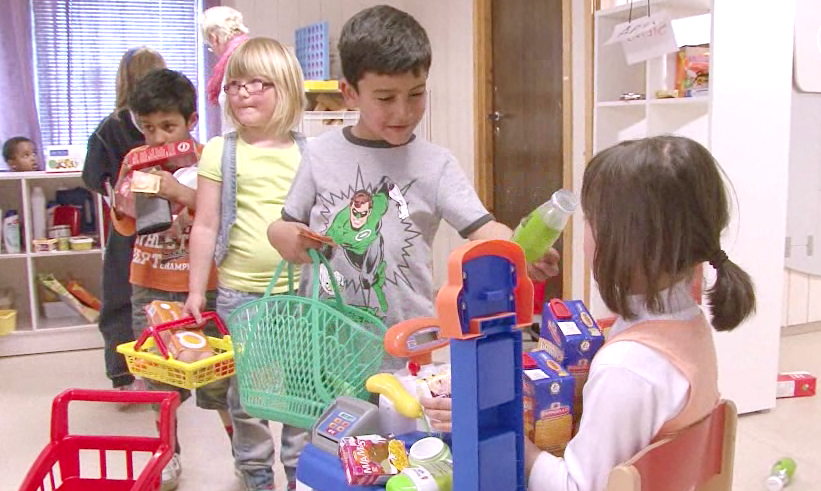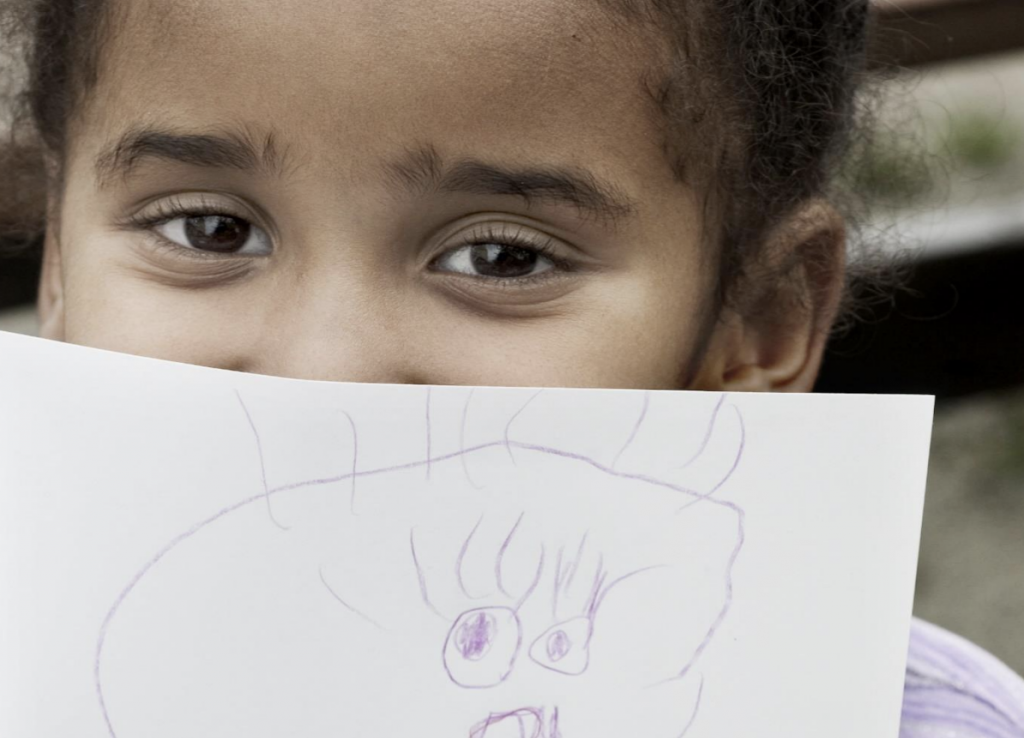Barn i flerspråklige familier // CHILDREN IN MULTILINGUAL FAMILIES Informational booklet
Informasjonsheftet belyser 10 spørsmål som ofte stilles om barns flerspråklige utvikling. I tillegg til å rette seg mot foreldre, er heftet svært aktuelt for ansatte i barnehager og skoler og på helsestasjoner. Det kan være et fint utgangspunkt for samtale mellom foreldre og ansatte i disse institusjonene om barnas flerspråklige utvikling.
Klikk på overskriften for tekst og lytt til lydfilen
Children can learn multiple languages at the same time. In many parts of the world it is common for children to learn several languages from very early childhood. Active assistance from home, kindergarten and school is required for children to develop multiple languages to a satisfactory level. It is important for the adults in the child’s life to encourage and support the development of the child’s multilingualism.
It is easier for families from minority backgrounds to stay in touch with friends and family in other countries if they maintain their native languages. Children in these types of families have a greater chance of participating in their parents’ cultural heritage if they have a good command of their parents’ language. This strengthens the child’s identity and sense of belonging.
Children have better prospects of learning a second language if they speak their native language well. The native language and the second language can support one another. For example if a child has learned a concept in his or her native language, such as ‘gaajaysan’ (the Somali word for ‘hungry’), it is easier to learn the corresponding Norwegian word ‘sulten’.
Every parent wants his or her child to do well at school. Therefore many parents want their children to learn Norwegian early on. This doesn’t mean that parents should stop using their native language when they speak with their child. Parents can help introduce their child to areas where they are exposed to the Norwegian language. Most often this takes place in kindergarten and the local environment, or in social encounters with friends of the family.
It is recommended that parents who speak different native languages use their respective native language when speaking with their child. When the whole family is together, they can choose to use what seems natural: one of their native languages, Norwegian or another shared language. The most important thing is for the parents to be able to communicate with their children in the language in which the parents are most fluent. It is also beneficial for children in families where one parent is a Norwegian speaker while the other speaks a different native language, if each parent speaks “their own” language. Norwegian often becomes the dominant language in these families. If the parents want their children to become multilingual, it’s important to support the child’s progress in both languages.
It’s completely normal for multilingual children to mix words from different languages in the same sentence. This may be because they have not yet learned to distinguish between the different languages, or, children may “borrow” words from the other languages as they need them. In these cases, children are using their total language proficiency.
It’s common for children to switch between languages when speaking with other bilingual people. They are using the option of switching between their different languages to convey a nuance or a feeling, or to create a feeling of fellowship between people who speak the same language. Many monolingual people may have a hard time understanding or accepting this type of switching. Research has demonstrated that a high level of linguistic awareness is necessary to be able to switch among languages well and that this is natural and practical in bilingual conversations.
Because we use the different languages in different contexts, it is common for multilingual children to have a better command of different areas and situations in one language rather than another. For example a child may have an easier time relating what happened at kindergarten in Norwegian, but may prefer to use his or her native language to discuss matters and situations concerning the home and family. A child may use his or her native language when speaking with older relatives and parents, but switch between languages when speaking with friends and siblings.

It’s not uncommon for bilingual children to prefer speaking Norwegian for certain periods, even though the parents try to be consistent about speaking with the children in their native language. If the child speaks in Norwegian when the parents speak their native language, the parents can try to help the child by using correct words and expressions in their native language when they respond. However contact and communication with the child is the most important thing, regardless of the choice of language. It’s more important to listen to what children have to say than to be preoccupied by which language they choose to say it. It’s a matter of being patient. It takes time for children to learn their native language in an environment where Norwegian has a strong influence and frequently higher status than their native language.
For a child to become multilingual, it’s important for the parents to continue speaking their native language with the child. It’s fortunate if there are other children and adults in the environment who share the child’s native language, so that the language serves a purpose outside the family as well.
Even if children don’t actively speak their parents’ native language, they are often able to understand much more than they can express. This can create the foundation for learning to use the language more actively later on.
Turkish-speaking children in Turkey and Norwegian-speaking children in Norway learn their native languages in many different situations and through contact with different people: within the family, with relatives and friends, at kindergarten, at school, in shops, on the street and on the bus.
These children have the chance to hear, speak and learn their native language all day long. Many children from minority backgrounds have limited opportunities to develop their native language in Norway. Most of these children will primarily hear and speak their native language at home. This places high demands on the parents, who along with kindergartens and schools must stimulate the children’s development in their native language. Adults in the children’s environment must create opportunities for them to speak their native language as much as possible, both inside and outside the family.
Many municipalities offer drop-in kindergartens where the parents are present along with their children. Families come there to meet other parents and children through play, activities, and social gatherings. In some municipalities the library offers story hours in different languages. The libraries also have books for children and young people, and audio books in several languages which can be borrowed. Find out which resources are available in your own municipality.
In addition parents, kindergartens and schools can make use of Det flerspråklige bibliotek (The Multilingual Library) at the Oslo Public Library, which has books for both children and adults in many different languages. Your local library can assist you in borrowing books from the Oslo Public Library. The website has books and audio books in different languages, as well as verses, songs and stories in many languages.

Going to kindergarten provides a sound basis for multilingual children’s progress in the Norwegian language. Good cooperation between kindergartens, family health centres, schools and parents is also important.
Kindergartens and schools bear a large responsibility for children’s progress in Norwegian, yet parents also play an important part in their children’s progress in the Norwegian language. Parents can support the language learning efforts taking place in kindergartens and schools, even if they do not speak Norwegian well themselves.
For pre-school age children, kindergartens can provide rich and varied opportunities for linguistic development. As these children grow older and go to school, SFO or municipal afterschool programmes, as well as recreational interests such as football, choir, dance, music and arts schools and similar activities, can be excellent settings for linguistic and social development. Parents can encourage their children to become involved with these activities.
Kindergartens are responsible for making arrangements for children’s language development at kindergarten, in close partnership with parents.
According to the Framework Plan for the Content and Tasks of Kindergartens, kindergartens must support them in their use of their mother tongue, whilst working actively to promote their Norwegian language skills. Parents can discuss their child’s needs for language stimulation with their kindergarten teacher, for example whether it is possible to have a bilingual assistant or offer other language education measures at kindergarten.
Children have different ways of learning a new language. Some children begin by trying words and sentences in the new language at once, while others wait for a long time, sometimes several months, before they express themselves in the new language. When a child starts going to a kindergarten where his or her native language is not spoken, it can be a demanding situation for the child. Close and secure interaction with adults at the kindergarten is especially important during this time. Even if the child does not speak Norwegian with children and adults at the kindergarten, it’s important to notice that the child communicates in other ways, such as by pointing and using mimicry and body language. The child is continually gathering knowledge and information about the new language, even if he or she is not speaking Norwegian. Some children may also have delayed language development or language difficulties for various reasons. In that case the kindergarten and the parents must cooperate to help the child, for example by obtaining outside assistance to assess the child’s language development and provide the help he or she needs both at home and at kindergarten.
Even if the child does not encounter other children or adults who speak his or her native language at kindergarten, acknowledgement of the native language is important for his or her multilingual development. Therefore parents should speak their native language with the child when they are at kindergarten – when it seems natural. At the same time staff members who do not share the child’s native language must show a positive interest in the child’s native language, for example by learning some words, songs and verses in the child’s native language. Having adults and children at kindergarten with a good command of the child’s native language is beneficial to the child’s multilingual development.
Many children do not have Norwegian as their mother tongue, and learn Norwegian as a second language at their kindergardens. It is important that these children are understood and get the opportunity to express themselves. Kindergartens must support them in their use of their mother tongue, whilst working actively to promote their Norwegian language skills.
Such support of the child’s native language can be provided in many ways, regardless of whether the staff know the child’s native language or not, but for many children it is extremely important to receive bilingual assistance at kindergarten.
Bilingual staff members can help provide a greater sense of assurance both for the child and for the parents, and can serve as a link between home and kindergarten. In the presence
of an adult who knows the child’s native language, the child can understand and make himself or herself understood in encounters with other children and adults at kindergarten. The child receives a valuable opportunity to make progress in his or her native language, while receiving support in developing skills in Norwegian.

The transition from kindergarten to school can be a big one for many children – and parents. Municipalities are encouraged to develop special cooperation procedures for this transition, and kindergartens must include plans for the transition from kindergarten to school in their annual plan. Parents can obtain information on this subject from their kindergarten or municipality.
- Du vil kanskje også like:
- Foreldresamarbeid
- Informasjonsmateriell til foreldre